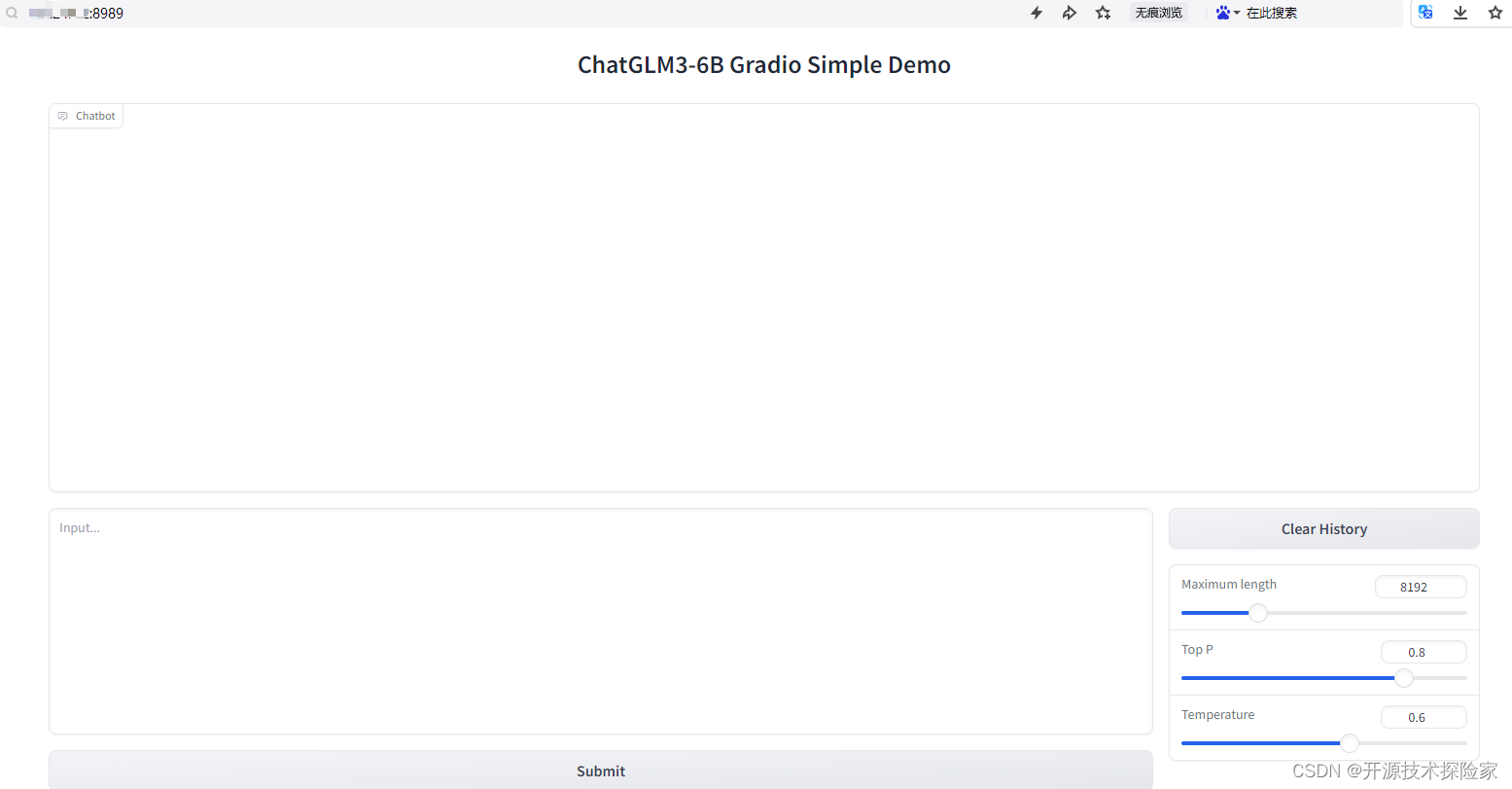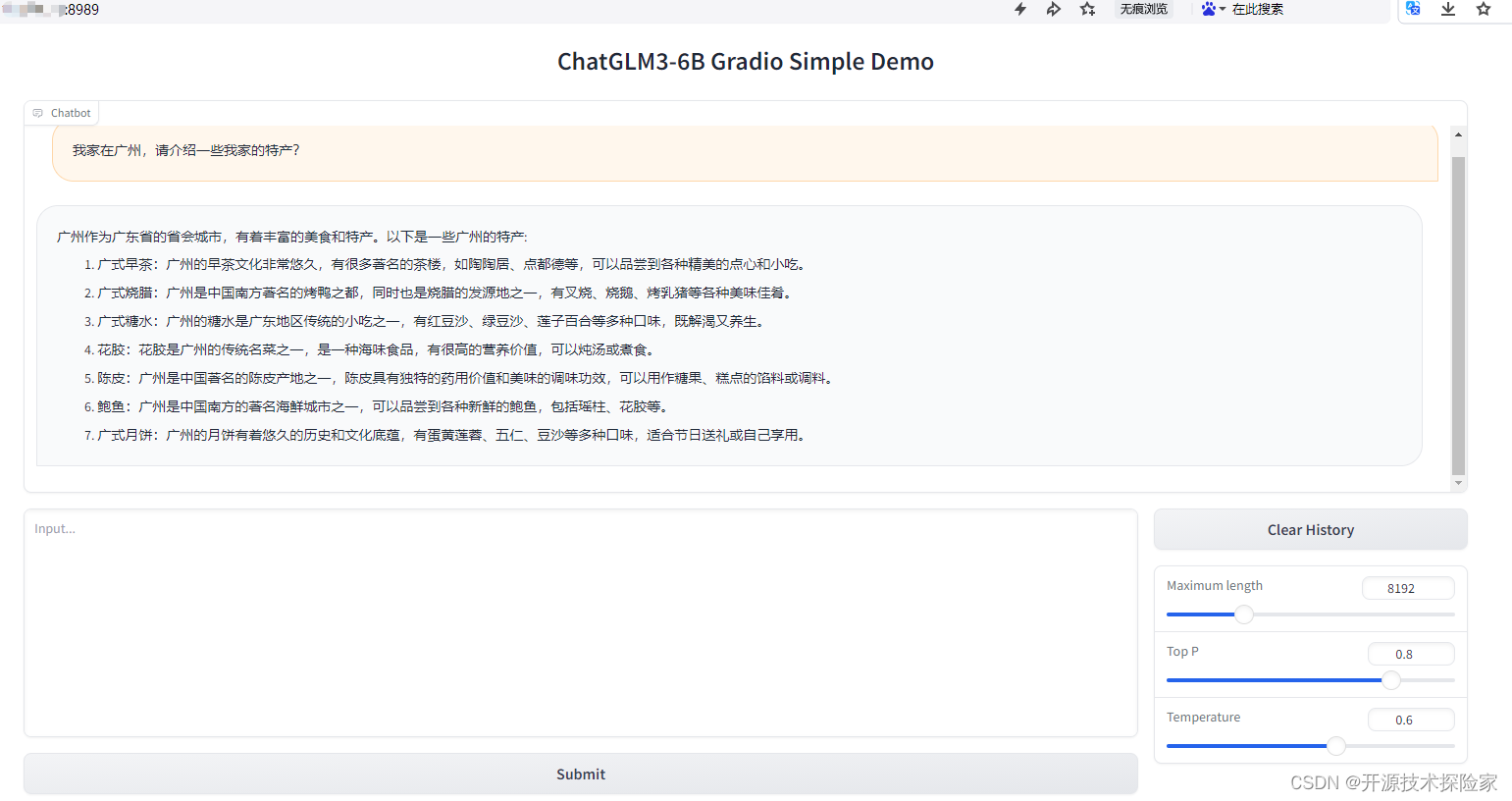一、前言
早前的文章,我们都是通过输入命令的方式来使用Chatglm3-6b模型。现在,我们可以通过使用gradio,通过一个界面与模型进行交互。这样做可以减少重复加载模型和修改代码的麻烦,
让我们更方便地体验模型的效果。
二、术语
2.1、Gradio
是一个用于构建交互式界面的Python库。它使得在Python中创建快速原型、构建和共享机器学习模型变得更加容易。
Gradio的主要功能是为机器学习模型提供一个即时的Web界面,使用户能够与模型进行交互,输入数据并查看结果,而无需编写复杂的前端代码。它提供了一个简单的API,可以将输入和输出绑定到模型的函数或方法,并自动生成用户界面。
三、前置条件
3.1. windows or linux操作系统均可
3.2. 下载chatglm3-6b模型
从huggingface下载:https://huggingface.co/THUDM/chatglm3-6b/tree/main

从魔搭下载:魔搭社区汇聚各领域最先进的机器学习模型,提供模型探索体验、推理、训练、部署和应用的一站式服务。https://www.modelscope.cn/models/ZhipuAI/chatglm3-6b/fileshttps://www.modelscope.cn/models/ZhipuAI/chatglm3-6b/files
** 3.3. 创建虚拟环境&安装依赖**
conda create --name chatglm3 python=3.10
conda activate chatglm3
pip install protobuf transformers==4.39.3 cpm_kernels torch>=2.0 sentencepiece accelerate
pip install gradio
四、技术实现
# -*- coding = utf-8 -*-
import gradio as gr
import torch
from threading import Thread
from transformers import (
AutoModelForCausalLM,
AutoTokenizer,
StoppingCriteria,
StoppingCriteriaList,
TextIteratorStreamer
)
modelPath = "/model/chatglm3-6b"
def loadTokenizer():
tokenizer = AutoTokenizer.from_pretrained(modelPath, use_fast=False, trust_remote_code=True)
return tokenizer
def loadModel():
model = AutoModelForCausalLM.from_pretrained(modelPath, device_map="auto", trust_remote_code=True).cuda()
model = model.eval()
return model
class StopOnTokens(StoppingCriteria):
def __call__(self, input_ids: torch.LongTensor, scores: torch.FloatTensor, **kwargs) -> bool:
stop_ids = [0, 2]
for stop_id in stop_ids:
if input_ids[0][-1] == stop_id:
return True
return False
def parse_text(text):
lines = text.split("\n")
lines = [line for line in lines if line != ""]
count = 0
for i, line in enumerate(lines):
if "```" in line:
count += 1
items = line.split('`')
if count % 2 == 1:
lines[i] = f'<pre><code class="language-{items[-1]}">'
else:
lines[i] = f'<br></code></pre>'
else:
if i > 0:
if count % 2 == 1:
line = line.replace("`", "\`")
line = line.replace("<", "<")
line = line.replace(">", ">")
line = line.replace(" ", " ")
line = line.replace("*", "*")
line = line.replace("_", "_")
line = line.replace("-", "-")
line = line.replace(".", ".")
line = line.replace("!", "!")
line = line.replace("(", "(")
line = line.replace(")", ")")
line = line.replace("$", "$")
lines[i] = "<br>" + line
text = "".join(lines)
return text
def predict(history, max_length, top_p, temperature):
stop = StopOnTokens()
messages = []
for idx, (user_msg, model_msg) in enumerate(history):
if idx == len(history) - 1 and not model_msg:
messages.append({"role": "user", "content": user_msg})
break
if user_msg:
messages.append({"role": "user", "content": user_msg})
if model_msg:
messages.append({"role": "assistant", "content": model_msg})
model_inputs = tokenizer.apply_chat_template(messages,
add_generation_prompt=True,
tokenize=True,
return_tensors="pt").to(next(model.parameters()).device)
streamer = TextIteratorStreamer(tokenizer, timeout=60, skip_prompt=True, skip_special_tokens=True)
generate_kwargs = {
"input_ids": model_inputs,
"streamer": streamer,
"max_new_tokens": max_length,
"do_sample": True,
"top_p": top_p,
"temperature": temperature,
"stopping_criteria": StoppingCriteriaList([stop]),
"repetition_penalty": 1.2,
}
t = Thread(target=model.generate, kwargs=generate_kwargs)
t.start()
for new_token in streamer:
if new_token != '':
history[-1][1] += new_token
yield history
with gr.Blocks() as demo:
gr.HTML("""<h1 align="center">ChatGLM3-6B Gradio Simple Demo</h1>""")
chatbot = gr.Chatbot()
with gr.Row():
with gr.Column(scale=4):
with gr.Column(scale=12):
user_input = gr.Textbox(show_label=False, placeholder="Input...", lines=10, container=False)
with gr.Column(min_width=32, scale=1):
submitBtn = gr.Button("Submit")
with gr.Column(scale=1):
emptyBtn = gr.Button("Clear History")
max_length = gr.Slider(0, 32768, value=8192, step=1.0, label="Maximum length", interactive=True)
top_p = gr.Slider(0, 1, value=0.8, step=0.01, label="Top P", interactive=True)
temperature = gr.Slider(0.01, 1, value=0.6, step=0.01, label="Temperature", interactive=True)
def user(query, history):
return "", history + [[parse_text(query), ""]]
submitBtn.click(user, [user_input, chatbot], [user_input, chatbot], queue=False).then(
predict, [chatbot, max_length, top_p, temperature], chatbot
)
emptyBtn.click(lambda: None, None, chatbot, queue=False)
if __name__ == '__main__':
model = loadModel()
tokenizer = loadTokenizer()
demo.queue()
demo.launch(server_name="0.0.0.0", server_port=8989, inbrowser=True, share=False)
调用结果:
启动成功:

GPU使用情况:

浏览器访问:

推理:

五、附带说明
5.1. 问题:AttributeError: 'ChatGLMTokenizer' object has no attribute 'apply_chat_template'
- transformers的版本太低,需要升级
pip install --upgrade transformers==4.39.3
5.2. 界面无法打开
- 服务监听地址不能是127.0.0.1

- 检查服务器的安全策略或防火墙配置
服务端:lsof -i:8989 查看端口是否正常监听
客户端:telnet ip 8989 查看是否可以正常连接
版权归原作者 开源技术探险家 所有, 如有侵权,请联系我们删除。